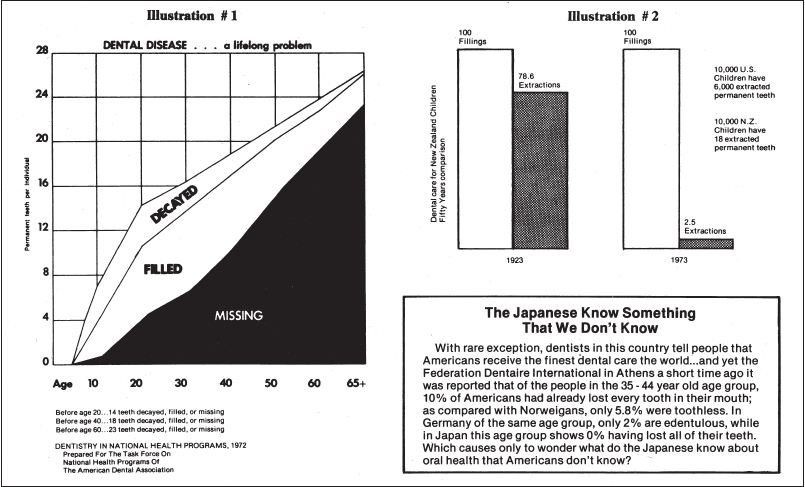BAD TEETH AND GUMS ARE A DISEASE PROCESS… NOT A “natural” aging process.
Can you glance up from this paper and see another person? Okay: As you read on, you might keep in mind that one of you two will probably die of heart disease. In fact, the national average is slightly higher than one out of two. Oh – You already knew that? Did you also know that many of those deaths were from a heart disease brought on by bad oral health; and sometimes by dental treatment?
The disease is called subacute bacterial endocarditis, a severe infection of the heart lining. In this condition bacteria collect at a previously damaged site within the heart. The prior damage can be from rheumatic fever, congenital defects, and other causes. Frequently, victims are unaware of this pre-existing damage.
Suppose a person has this pre-disposition to bacterial endocarditis. Where do the bacteria come from? How do they get from “outside” all the way to the interior of the heart? First, let’s look at how bacteria reach the heart once they do get into the interior: They simply “hitchhike” through the body’s freeway system; the blood stream.
Doctors call this unauthorized use of the circulatory system bacteremia. An “ -emia” is simply an excess of anything in the blood. Since there should never be any of these germs inside the body, enough to cause trouble is definitely an “excess;” it is bacteremia. Bacteria enter the body through a failure of natural defensive barriers. One such barrier is skin. Another is the tooth structure. These surfaces are not, themselves, vulnerable to germs; and they prevent germs from access to inner tissues which have no natural immunity, no defense.
In order to survive once they invade, germs must have – or adopt – certain characteristics: they must be able to survive and multiply at temperatures near 98°, normal body temperature; they must be able to extract nourishment from the blood or from internal tissues; and they must be anaerobic, able to thrive in the absence of “free” oxygen (atmosphere.) The only oxygen in the blood is wrapped up inside red corpuscles. An “aerobic” germ would simply suffocate, just as we would, in the absence of oxygen; an anaerobic microbe is at home in an oxygen-free environment.
Is there anyplace on the outside of the body where such bacteria can survive? And, if we find such a place where anaerobic germs can thrive outside the barrier tissues, what is the condition of those tissues?
If there are dangerous microbes lying in ambush outside the gates, how strong are the gates? There is one part of the human body which is consistently at or near internal body temperature, is rich in microscopic nourishment, is extremely moist and slightly saline, and is anaerobic. It is also on the outside of a barrier surface.
In fact, if the bacteria were allowed to design a perfect place to lie in ambush, they probably couldn’t create a better site. From the viewpoint of such germs, it is the perfect environment. This site is found at the base of nearly all human teeth; in the area between the tooth and gum surface. It is not a danger zone if oral health is disease-free…but please don’t breathe a sigh of relief just yet. If you are one of millions of Americans who assume your oral health is safe, think about what Dr. Charles C. Bass had to say in the “American Heart Journal:”
Bacteria in the periodontal pocket and in diseased periodontal tissues are the source of almost all bacteremia from the environment of the teeth. Periodontoclasia (pyorrhea) is a universal disease of man, originating as gingivitis in childhood, continuously advancing during adulthood, and never ending so long as any teeth remain.
With the exception of those few persons who have learned and continuously follow the only entirely effective method of personal hygiene ever known, every dentulous (with teeth) adult now has demonstrable, active, advancing periodontoclasia lesions in some stage about most or all of his or her teeth. This includes all heart patients and, incidentally also, all dentulous cardiologists …
We would add only one thought to Dr. Bass remarks: This includes you…and your dentist. Should you be concerned about the condition of your teeth and gums? Let’s return to Dr. Bass, in the same article:
Prevention of these dental diseases should also prevent those diseases of the heart in which the infection comes from such foci. Under these circumstances, the health welfare, and even life itself, of persons who have heart conditions which predispose to infection may depend upon prevention and control of dental disease.
What is a periodontal pocket?
And more than that, how do I know whether I have any? How do I get rid of them?
The normal “gap” between the base of a tooth and the adjacent healthy gum tissue is about two millimeters deep; about one-sixteenth of an inch. Bacteria lodge in this tiny “trench” (called the gingival crevice) and begin to multiply and produce toxins – poisons. Through a well understood mechanism, this causes the crevice to deepen, ultimately forming the “pocket.” It is normal to have pockets without knowing it. Such pockets are festering cesspools of mixed bacteria, with one important thing in common: They are anaerobic.
There is no atmospheric oxygen in a periodontal pocket. The gum tissue, when healthy, is a germ barrier. When infected, then its one-cell-thickness is pierced by anything – it can no longer act as a barrier. Bacteria can then enter the blood circulatory system almost at will. When they do, the victim has bacteremia.
If he or she also has a heart defect which predisposes to bacterial infection, that person may be in deep trouble. The only known method of counter-acting periodontal disease is a very specific hygiene method . Periodontal surgery, often performed when the disease damage has become severe, may relieve symptoms and retard the disease progress; but surgery does not cure the disease itself.
RobertNara.com has numerous brochures on this subject; and it is covered in detail in the book How To Become Dentally Self-Sufficient.
Even if you don’t have (or don’t think you have) heart damage, eliminating periodontal disease is the only sure method of keeping your teeth and enjoying better overall health. If you have a heart problem, understanding periodontal disease is just as Dr. Bass said it: “…the health welfare, and even life itself, of persons who have heart conditions…may depend upon prevention of dental disease.”
Charles C. Bass, M.D., Dean, Emeritus and Professor of Experimental
Medicine, Emeritus, Tulane University School of Medicine, New Orleans, LA.,
AmHeart J., V691 Number 5.
Is there a statistical correlation between heart deaths and oral health? The fields of dentistry and medicine have been divorced for so long that statistics – and joint research – are virtually unobtainable. However, comparison of the two charts seen here provides food for thought. It goes without saying that the steady climb in percentages of heart-related deaths is, to a large degree, a simple function of the human aging process. However, that can also be said for the age-related upward curve of “decayed, missing and filled teeth” as shown on the oral health graph – and that is totally misleading! There is no reason for anyone to suffer decayed, missing or filled teeth, regardless of age. BAD TEETH AND GUMS ARE A DISEASE PROCESS .. . NOT A “natural “ aging process.
The question still to be answered: How many of the heart disease deaths in the “over 24 portion of the graph actually result from a completely preventable oral health disease…pyorrhea?

